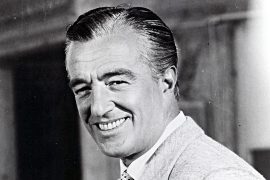The American actress and singer celebrated her breakthrough in the mid-1940s with hits such as “Sentimental Journey” and “My Dreams are getting better all the time” before she took over with comedies such as “Pillow Talk” or “A Pajama for Two”. side of Rock Hudson to become a Hollywood star. One of her most popular songs was her piece “Que sera” from the Hitchcock thriller “The Man Who Knew Too Much” (1956). In her roles, Doris Day embodied the lovable blonde and the simple, honest and erotic nanny in the spirit of the 1950s and 1960s. Later she also worked for television. From the mid-1970s she withdrew almost entirely from the industry. In her private life, she increasingly campaigned for animal welfare, for which Day was awarded the Presidential Medal of Freedom in 2004…
Doris Day, whose real name is Doris Mary Ann Kappelhoff, was born on April 3, 1922 in Cincinnati, Ohio.
Doris Day’s parents were both of German descent. Doris Day got her stage name after the hit “Day After Day”. She attended Withrow High School in Cincinnati and then Fanchon And Marco Dance School in Los Angeles, where she was also trained in classical ballet. At first, Doris Day devoted herself to music and appeared as a singer and dancer. In the late 1930s she was part of Barney Rapp’s band. After that she sang in the bands of Fred Waring and Bob Crosby. Her breakthrough came in the mid-1940s with the #1 hit “Sentimental Journey,” followed by “My Dreams Are Getting Better All the Time.” Her first marriage was in 1941 to trombonist Al Jordan. The connection was broken as early as 1943. Their son Terry was born in 1942. In 1946 she married George Weidler, but this marriage also ended in divorce after a short time.
From 1943 to 1946 she was the singer of the “Les Brown Band”. From 1948 Doris Day made solo recordings and devoted herself more and more to acting. Before film producers discovered her, she appeared in programs with Frank Sinatra, Bob Hope and Dinah Shore. Then it was director Michael Curtiz who got her her first film role. Associated with a contract with “Warner Bros.” her film career began in Hollywood. From 1948 she appeared as an actress and became a world star with films such as “Pillow Talk” or “Spion in Lace Panties”. In 1951 she married her manager Martin Melcher. In addition to comedic roles, she also occasionally cast dramatic roles, such as in the films “Prisoners of the Ku Klux Klan” (1951), “Nightclub Affaires” (1955) or “Murder in the Clouds” (1956).
She starred in the 1956 Alfred Hitchcock thriller The Man Who Knew Too Much, in which she also featured as a singer with the song Que sera, and was credited for her role as Jan Morrow opposite Rock Hudson in “Pillow Talk” with an “Oscar” nomination. After that, Doris Day starred in a number of other musical comedies and enjoyed great success. Through her film roles, Doris Day quickly fell into the cliché of the naïve blonde, who presented herself as staid and conservative but also erotic in the staid American zeitgeist of the 1950s. She appeared in a total of 17 films in the 1960s, including the hits “One Too Many in Bed”, “What This Woman Is Doing”, “Don’t Send Me Flowers”, “Do Not Disturb” and in “The Devil’s Woman of Texas”. In 1968, Doris Day shot what was her last feature film for the time being, entitled “What is the man doing in Mommy’s bed”.
Her third husband, Martin Melcher, had died in the same year and had spent a large part of her fortune. So she looked for new jobs and got her own “Doris Day Show” on television, which was broadcast from 1968 to 1973. In 1985 she began her TV series show “Doris Day And Friends”. After a few successful years, she retired and kept ignoring rumors of her TV return. In 1989 she received the “Cecil B. DeMille Award” from the Foreign Press Association in Hollywood for her life’s work. Doris Day only returned to cinemas in 1993 with the film “Hearts and Souls”. After that, Doris Day lived completely secluded from the public in Carmel, California. From here she increasingly campaigned for animal welfare, for which she was awarded the Presidential Medal of Freedom in 2004.
Doris Day died on May 13, 2019 in Carmel Valley Village, California, United States.
Table of Contents
What is Doris Day known for?
Doris Day, original name Doris Von Kappelhoff, (born April 3, 1922, Cincinnati, Ohio, U.S.—died May 13, 2019, Carmel Valley, California), American singer and motion-picture actress whose performances in movie musicals of the 1950s and sex comedies of the early 1960s made her a leading Hollywood star.
What impact did Doris Day have on society?
She later received the Presidential Medal of Freedom in 2004 for her work as an actor and activist, and received an Honorary Grammy Award in 2008. Today, her run of iconic postwar films continues to influence women’s fashion, style, and even lifestyle choices.
What accident did Doris Day have?
Day was actually a distinguished child dancer in her hometown of Cincinnati, Ohio, before a tragic car accident cut her career short in 1937 at the age of 15. The actress was driving with friends when a train struck their car twice, shattering her right leg.
Why did Doris Day change her name?
While performing for a local radio station, she was approached by band leader Barney Rapp who felt her last name, Kappelhoff, was clumsy and unappealing. Rapp convinced Doris to change her last name after one of the songs in her playlist, “Day by Day.”
Why did Doris Day quit acting?
A few years later, Day moved out of Los Angeles and into a 10-acre estate in Carmel, California, eschewing acting in order to devote herself to rescuing animals and championing animal-rights activism.





